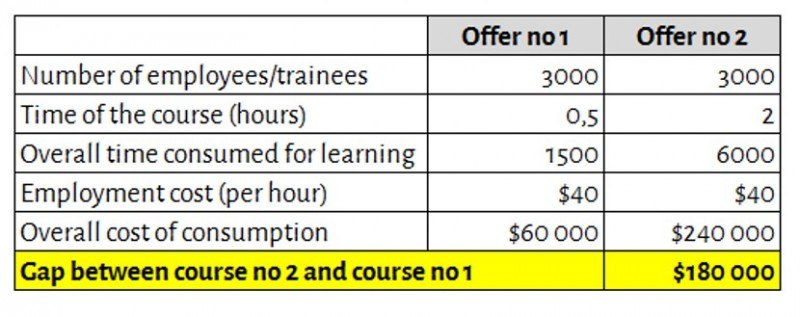What Is The Cost Of eLearning Consumption
Let’s imagine you have to build new competence among the 3.000 employees of your company. Considering the scale of such learning intervention, you decide to do it by ordering the design and development of an eLearning course. You have a cooperating, tried, and tested company το create such a course with good quality and timely. You ask them to prepare the course and you receive two completely different offers:
- Simple Approach.
The first offer is based on a very simple approach. The development company proposes to build a simple presentation based on static visuals and short texts (leads, bullet point lists, catchwords, etc.). Such an eLearning course will be quite short (30 minutes long), simple, with no voice overs. It will get to the point and focus on the most important issues. Your partnering company demands for this service 5.000 USD. - Advanced Approach.
The second offer is based on an advanced approach which will cover various high-end techniques like gamification, role-plays, and highly interactive quizzes. The eLearning course will utilize interactive movies and printable materials, and will be supported by audio track. It will cover all aspects of competence to be built from various perspectives and let trainees not only read about it, but also practice it with many examples and exercises. Employees will need about 120 minutes to consume this kind of course. It will cost you 30.000 USD.
Your Choice
Well; it seems that the choice is quite simple. In the offer No1 you will probably get a boring page-turner. In the offer No2 you will get advanced solutions including all trendy features. The gap of the cost is substantial, but you are ready to pay for a better formula which you consider important.
The Gap
As offer No2 costs 30.000 USD and offer No1 just 5.000 USD, it seems that the gap between costs is equal to 25.000 USD. Well; it is not so simple... This is just the gap between the costs of course development. What about the cost of eLearning consumption?
If we assume that the whole target group will participate in the course, consumption of the first one will take 1.500 hours, and the second one will take 6.000 hours. Learning requires time which will cannibalize other on-the-job duties. This time will be paid by your company: This is your additional cost.
Let's take a look at some calculations below:
Adding this value to the easy-to-find development cost changes the game, doesn’t it? If we consider both of these numbers we will get $200.000+ of additional costs related with eLearning course number 2.
Conclusion
I fully understand that course number 2 is better; it has much bigger development power. Its users will be probably more engaged, will remember more important facts and techniques, will have a chance to practice and experience things, etc. But I have seen many situations in which a simple eLearning course was good enough to deliver the promise.
It is useless to pay more for a product with surplus functionalities and features, especially if we have to pay not only for its development but also for its usage.
So if the competence can be built with a simple solution, buy the simple one. What you need to do in such situation, however, is to push development team to create it with passion to make it as good as possible considering its simple form.





![Top 20 eLearning Statistics For 2019 You Need To Know [Infographic]](https://cdn.elearningindustry.com/wp-content/uploads/2019/08/top-20-elearning-statistics-2019-need-know.png)


